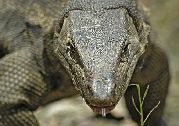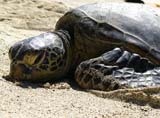
Green Turtle (Soup Turtle)
GREEN TURTLE (Chelonia mydas) or soup turtle is widely known in many countries due to its delicious meat and incomparable turtle soup. This turtle is larger than the other species of the family. The weight of large turtles reaches 200, and in rare cases even 400 kg. The rounded-oval low carapace is covered with large horny shields, the edges of which never overlap each other. Males are easily distinguished from females by a more flattened and elongated shell, and especially by a much longer tail (more than 20 cm)
Other names
Chelonia mydas,
soup turtle,
Hawaiian green turtle.
Subspecies
 Chelonia mydas mydas (Atlantic green turtle) – this subspecies is distributed near the coasts of North America and Europe. Turtles of this subspecies have a wider shell, but they themselves, at the same time, are flatter.
Chelonia mydas mydas (Atlantic green turtle) – this subspecies is distributed near the coasts of North America and Europe. Turtles of this subspecies have a wider shell, but they themselves, at the same time, are flatter.
Chelonia mydas agassizi (Eastern Pacific green turtle) – turtles of this subspecies sometimes have a black carapace. They are distributed throughout California, reach Chile, and are found near Alaska. Their carapace is somewhat narrower (about 117 cm long), the weight, on average, reaches 126 kg, but in itself it is higher.
Inhabitation
 The green turtle is widespread in the territories of subtropical and tropical regions of the oceans, especially in the waters of the Pacific and Atlantic oceans. Distributed in territories from the coastal regions of Belgium, Holland and Great Britain to South African waters, from the northern coastal waters of the United States to the coast of Argentina. Found off the Philippine and Sunda Islands, off the coast of Australia.
The green turtle is widespread in the territories of subtropical and tropical regions of the oceans, especially in the waters of the Pacific and Atlantic oceans. Distributed in territories from the coastal regions of Belgium, Holland and Great Britain to South African waters, from the northern coastal waters of the United States to the coast of Argentina. Found off the Philippine and Sunda Islands, off the coast of Australia.
Most often, this turtle prefers to be located in coastal waters, but it can also be found in the open sea. More than others, this turtle loves places with uneven bottoms and those places where there are caves and grottoes in which turtles climb to rest.
Description
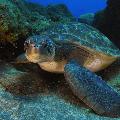 In many countries of the world, this turtle is primarily known for its incredibly tasty meat and the amazing turtle soup that is prepared from it.
In many countries of the world, this turtle is primarily known for its incredibly tasty meat and the amazing turtle soup that is prepared from it.
This is a fairly large turtle. The length of its shell varies from 70 to 150 cm. The shell itself perfectly protects the adult green turtle. It is so strong that under natural conditions, only large sharks can eat an adult.
The average body weight is 200 kg, although there are individual individuals reaching a weight of 400 kg. Despite its name, its top color is not only olive green, but often dark brown, with white and yellowish stripes and spots. In fact, the turtle got its name not so much because of its color, but due to the color of the fat that accumulates on the carapace from the inside.
The shell of a green turtle is covered with horny shields, while their edges never overlap each other. Her head is also covered with symmetrical large shields. The muzzle is rounded in front. The eyes of the soup turtle, however, like those of other sea turtles, are large, with a beautiful lenticular slit of the eyelids, which is directed back and up, and with a round pupil.
Males have a much larger tail than females (about 20 cm), they also differ from females in a longer and flattened shell.
The green turtle acquires real mobility and power only in water. When this turtle swims, its movements are more like the flight of a giant bird of prey, such as, for example, an eagle.
These turtles are amazing swimmers. Their movements are equally distinguished by speed and strength, beauty and endurance. The green turtle is equally well able to stay still in the water and dive at different depths. In the water, this turtle is able to take various positions of the body, more or less avoiding the horizontal position.
The green tortoise is a very cautious species that does not have a brave demeanor. She rarely actively defends herself. Most often, these turtles tend to quickly get away from aggression.
Food
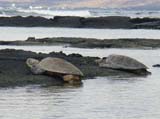 The main food of the green turtle is aquatic plants, especially thalassia and zoster, which grow at a depth of 4-6 meters. The green turtle also feeds on other algae, and sometimes mollusks, arthropods, and jellyfish are also eaten, though most often at a young age.
The main food of the green turtle is aquatic plants, especially thalassia and zoster, which grow at a depth of 4-6 meters. The green turtle also feeds on other algae, and sometimes mollusks, arthropods, and jellyfish are also eaten, though most often at a young age.
Reproduction
Puberty in a green turtle occurs at the age of 10 years.
The breeding season falls on a different time, depending on the habitat of the turtle. For example, on Ascension Island, the breeding season lasts from January to June, in Ceylon from July to November, and in the Caribbean from May to October. At this time, turtles migrate in herds to the places of laying eggs. The main one is a small island in the central Atlantic – Ascension Island. These long-distance migrations made by green turtles have been a topic for study by herpetologists of the world for many years. In particular, by marking animals and survey data, it was possible to prove that turtles of this species are able to cross the open spaces of the sea during migrations, while clearly maintaining their orientation. For example, turtles that live off the coast of Brazil swim about 2 kilometers to lay their eggs on the shores of Ascension Island.
It has long been believed that the green turtle lays its eggs in the same place where it itself was born. Using the analysis of mitochondrial DNA, it was revealed that if the turtle changes the place of oviposition, then this happens extremely rarely.
During the above migrations, turtles are guided by sea currents and by the movement of waves. The magnetic field of the planet, and possibly the stars with the sun, also serve as a reference point. The researchers also suggest that green turtles find the right way, focusing on the smell that is carried by the ocean current.
During these migrations, the males follow the females, but during laying they do not go ashore, but remain nearby in the sea. Mating itself takes place in coastal waters, and at night the female crawls out onto land to lay eggs.
Before going out on land, the female takes additional precautions, namely, as if wanting to drive away an invisible enemy, she makes whistling sounds. Being behind the surf line, approximately at a distance of 30 meters from the tide line, the female chooses a suitable place for laying. She breaks a shallow depression with her feet, then begins to dig a nest. She digs it only with her hind legs to a depth of about 20 cm.
In clutch there are from 70 to 200 eggs, spherical in shape, about 5 cm in diameter, covered with a leathery shell. At the same time, the Atlantic green turtle lays fewer eggs than the Pacific green turtle.
After the laying is done, she buries the nest and smoothes the sand to hide the nest location from predators and protect the laying from direct sunlight. The incubation period lasts an average of one and a half to two months. Turtles break open egg shells with their egg teeth.
The sex of the turtles is determined by the temperature regime at which the clutch is incubated. Thus, if the temperature is less than 26 degrees, then only males will develop from eggs, and at temperatures above 29 degrees, only females develop.
During the breeding season, the female can make from 2 to 5 clutches at intervals of two weeks.
Despite all the precautions that the female takes to protect her offspring, the female, unfortunately, cannot completely protect the clutch from predators that ruin it. Masonry is ruined by various predators, as well as poachers. After the birth of the young, rushing to the water, they are at great risk. On the way to the water, predators are waiting for them, and in the water itself, schools of predatory fish pose a threat. In this regard, only some individuals manage to stay alive.
Content
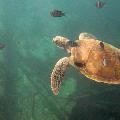 The green turtle, however, like other representatives of the family of sea turtles, live in tropical and warm seas, so its maintenance will require a large pool with high-quality warm sea water. The water temperature should be 22-26 degrees. Due to their rather large size, adults need a lot of space for swimming, so the pool should not only be large, but also preferably round.
The green turtle, however, like other representatives of the family of sea turtles, live in tropical and warm seas, so its maintenance will require a large pool with high-quality warm sea water. The water temperature should be 22-26 degrees. Due to their rather large size, adults need a lot of space for swimming, so the pool should not only be large, but also preferably round.
Representatives of this family have a very intensive metabolism; thorough filtration of water in the pool will be required. Sometimes it will even be necessary to partially replace the water in order to stabilize the pH level.
To prevent injury to the turtle, it is necessary to ensure that the sides of the pool are sufficiently smooth. Silicone seams should be closed on the sides of the pool, as turtles can pull them out and eat them. Waste and food remains must be systematically sucked from the bottom of the pool.
Additionally
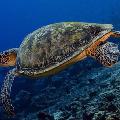 At the beginning of the 16th century, while crossing the Caribbean Sea, Columbus was struck by giant herds of these turtles, which were so plentiful that it was extremely difficult to navigate the ship through the almost impenetrable mass of these turtles in the Cayman Islands. Then Columbus gave the islands he discovered the name Las Portugas (turtles). True, like the herds of turtles themselves, the name of these islands has not been preserved. Now in these waters it is hard to find at least one turtle.
At the beginning of the 16th century, while crossing the Caribbean Sea, Columbus was struck by giant herds of these turtles, which were so plentiful that it was extremely difficult to navigate the ship through the almost impenetrable mass of these turtles in the Cayman Islands. Then Columbus gave the islands he discovered the name Las Portugas (turtles). True, like the herds of turtles themselves, the name of these islands has not been preserved. Now in these waters it is hard to find at least one turtle.
Just like the land tortoises from the Galapagos Islands, green turtles were a source of food for filibusters, sailors and whalers. Her meat was dried and salted, often even turtles were transported alive. It is not for nothing that the green turtle is said to have played an important role in the development of the Caribbean Sea.
The green turtle has very tasty meat and eggs, due to which, the consumption of this species of turtle in food has led to the fact that the species has been significantly reduced. Now hunting for this turtle is prohibited by the laws of most countries.
Since the 60s of the 20th century, active work has been carried out to breed and preserve this species on special farms and in reserves. However, despite widespread bans on the extraction of these turtles, their numbers are declining. The point is also in simple ways to prey on representatives of this species – it is enough just to turn the turtle that has climbed ashore upside down – it will not be able to get out of this situation on its own and will be completely helpless.
Sources of
http://www.floranimal.ru
http://ru.wikipedia.org
http://www.cherepahi.ru
http://www.vtropiki.com
http://www.mad-love.ru
http://www.althaiman.ru



